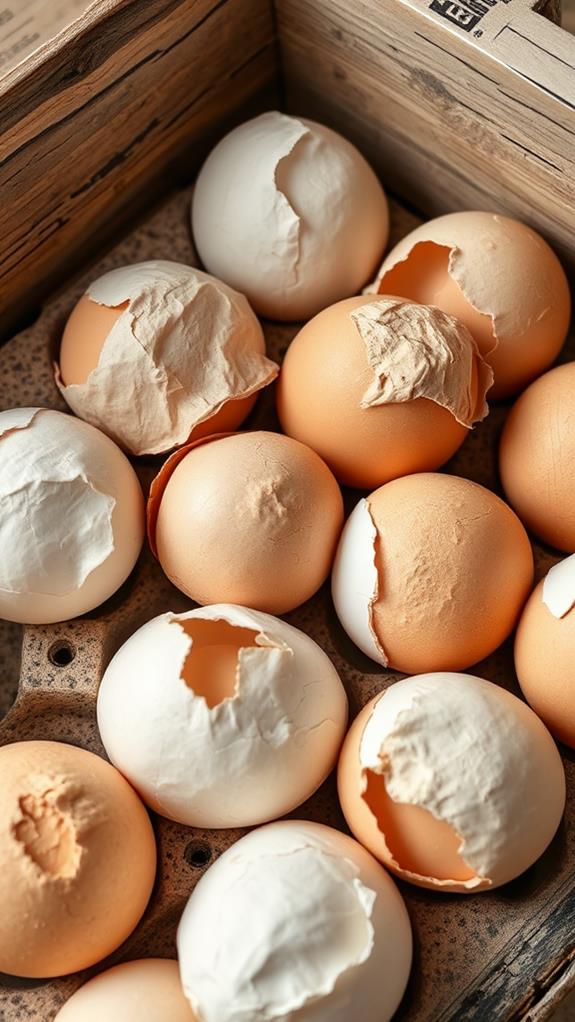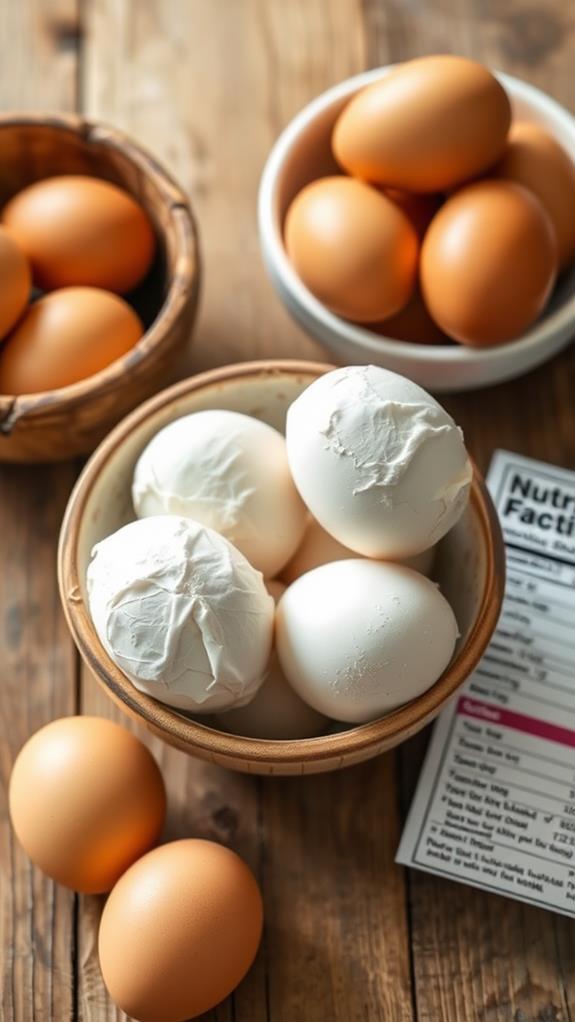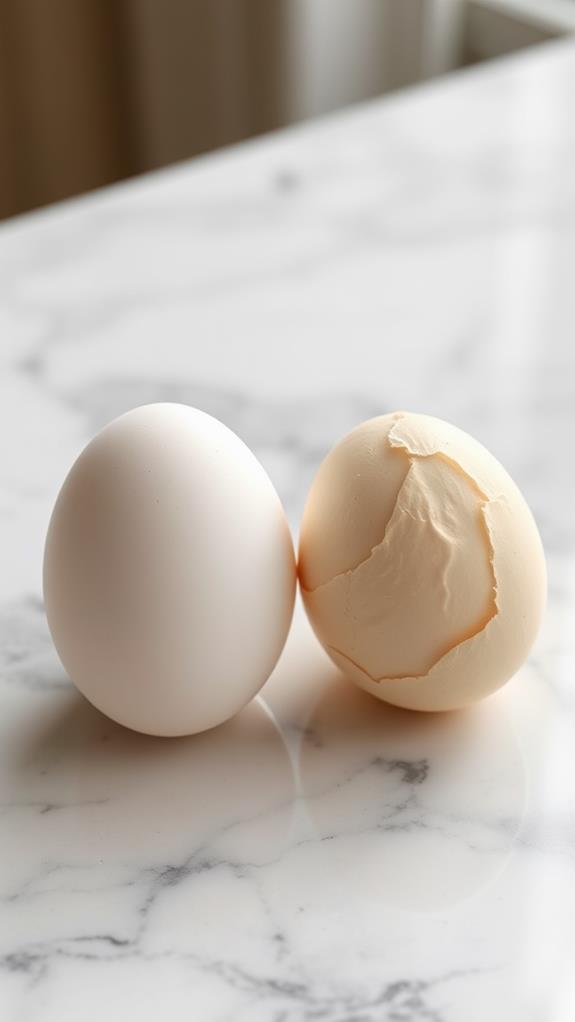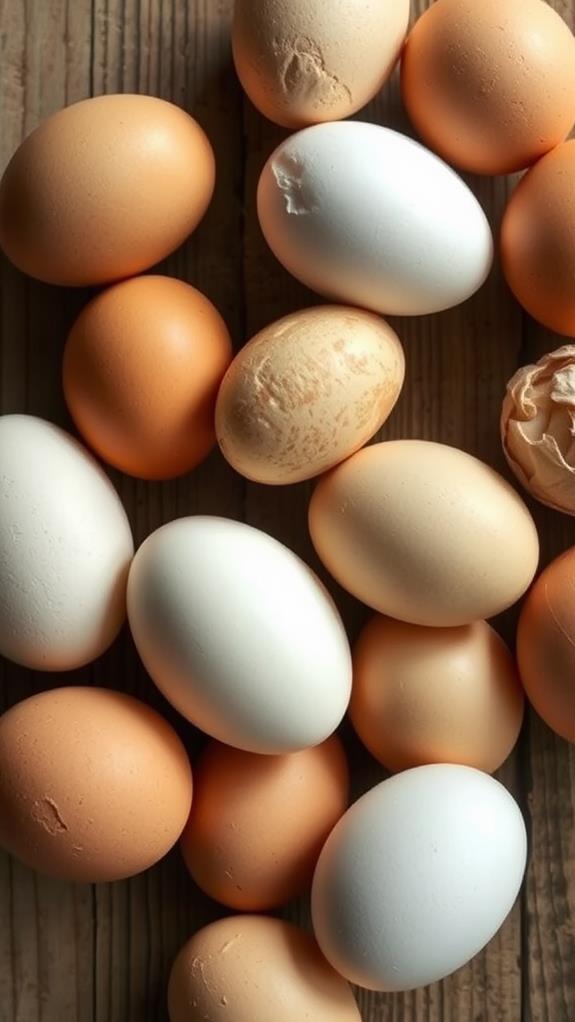Are Wrinkled Eggs Safe to Eat
Wrinkled eggs are generally safe to eat, as long as their shells aren't cracked or leaking. The wrinkles don't affect the egg's interior or nutritional value. These texture variations can result from factors like the hen's age, environmental stress, or inadequate nutrition. While bumpy shells may look unusual, they don't necessarily indicate unsafe eggs. However, you should always inspect eggs carefully before use, regardless of shell appearance. Proper handling and cooking are essential for food safety. Remember that severe abnormalities might signal underlying health issues in the hen. If you're unsure about an egg's safety, it's best to err on the side of caution. Exploring the causes and implications of egg shell textures can provide valuable insights for consumers and producers alike.
This post may contain affiliate links. If you make a purchase through these links, I may earn a commission at no additional cost to you. Additionally, portions of this post may be generated using artificial intelligence (AI) technology. While we strive for accuracy, please be aware that AI-generated content may not always be perfect and should be fact-checked when necessary.
The Spatula Scoops
- Wrinkled eggs are generally safe to eat if the shell is intact and not cracked.
- The wrinkled texture doesn't affect the egg's interior quality or nutritional value.
- Careful inspection for cracks or leaks is essential before consuming wrinkled eggs.
- Proper handling and cooking are crucial for food safety, regardless of shell texture.
- Wrinkled eggs contain the same essential nutrients as smooth-shelled eggs.
What Causes Wrinkled Eggs

Several factors can lead to wrinkled eggs. The most common cause is the age of the laying hen. As chickens get older, they produce larger eggs with thinner shells, which are more prone to wrinkling. Environmental stress, such as extreme temperatures or inadequate nutrition, can also contribute to this phenomenon. If a hen's diet lacks essential nutrients like calcium, it may result in weaker eggshells that wrinkle easily. Proper storage techniques are vital for maintaining egg quality, as leaving eggs unrefrigerated for extended periods can lead to moisture loss and wrinkled shells.
Another factor is the egg's moisture content. If an egg loses too much moisture during formation or after laying, it can develop a wrinkled appearance. This is often seen in eggs that have been stored for extended periods or in low-humidity environments. Additionally, certain diseases affecting the hen's reproductive system can cause abnormalities in egg formation, leading to wrinkled shells.
Sometimes, wrinkled eggs occur due to genetic factors or breed characteristics. Certain chicken breeds are more predisposed to laying eggs with textured or wrinkled shells. It is critical to recognize that while these factors can affect the egg's appearance, they don't necessarily impact its safety or nutritional value.
Safety of Bumpy Egg Shells
When you encounter an egg with a bumpy or wrinkled shell, it's important to understand the potential causes and health risks. Shell irregularities can stem from various factors, including the hen's age, diet, or stress levels, but they don't necessarily indicate unsafe eggs. Similar to the importance of proper rice cooking, guaranteeing eggs are handled and prepared securely is essential for preventing foodborne illness. You'll need to carefully inspect the egg, checking for cracks or leaks, and use proper handling techniques to affirm its safety for consumption.
Causes of Shell Irregularities
Chickens, like all living creatures, can experience factors that affect their egg production. These factors can lead to shell irregularities, including wrinkles, bumps, and other abnormalities. You'll often find that egg shell quality is directly linked to a hen's health and environment.
Several causes can contribute to shell irregularities:
- Stress: Environmental changes, predators, or social disruptions can impact egg formation
- Nutritional deficiencies: Lack of calcium or other essential minerals affects shell structure
- Age of the hen: Older hens may produce eggs with thinner or more irregular shells
Disease and infections can also play a role in shell quality. For instance, infectious bronchitis can cause wrinkled or misshapen eggs. Additionally, extreme temperatures, particularly heat stress, can lead to thinner shells or other abnormalities.
Genetics can influence egg shell texture as well. Some breeds are more prone to laying eggs with particular characteristics. It is crucial to recognize that while these irregularities may affect the egg's appearance, they don't necessarily impact the edibility or nutritional value of the egg itself. However, severe abnormalities could indicate underlying health issues that might require attention from a veterinarian.
Bumpy Egg Health Risks
Bumpy egg shells might set off alarm bells for some consumers, but they're generally safe to eat. These irregularities often result from natural variations in the egg-laying process and don't necessarily indicate a health risk. However, it's vital to inspect bumpy eggs carefully before consumption.
When you encounter a bumpy egg, check for any cracks or breaks in the shell. If the shell is intact, the egg's contents are likely protected from bacterial contamination. You'll want to pay attention to the egg's overall appearance, smell, and texture once cracked open. If you notice any unusual odors or discoloration, it's best to discard the egg.
It's worth noting that while bumpy shells don't inherently pose a health risk, they may indicate stress or nutritional deficiencies in the laying hen. This could potentially affect the egg's nutritional content, but not its safety for consumption. As with all eggs, proper handling and cooking are of the utmost importance to minimize any potential foodborne illness risks. Always refrigerate eggs promptly and cook them thoroughly to guarantee food safety.
Proper Egg Inspection Techniques
Proper inspection of eggs with bumpy shells is key to ensuring their safety for consumption. When examining eggs, you'll want to focus on several key aspects. First, check the shell's integrity. While bumps are normal, look for any cracks or breaks that could allow bacteria to enter. Next, assess the egg's overall appearance, including its color and texture.
To thoroughly inspect an egg, follow these steps:
- Hold the egg up to a bright light source, a process called candling
- Rotate the egg slowly, examining all sides for abnormalities
- Gently shake the egg to check for any internal movement
If you notice any unusual odors, discoloration, or excessive movement inside the egg, it's best to discard it. Remember, the "float test" isn't a reliable indicator of freshness or safety. Instead, rely on your visual inspection and the egg's expiration date.
When in doubt, it's always safer to err on the side of caution. If you're unsure about an egg's safety, it's best to avoid using it. By following these proper inspection techniques, you'll be better equipped to determine whether bumpy eggs are safe for consumption.
Nutritional Value of Wrinkled Eggs

The nutritional value of wrinkled eggs doesn't differ markedly from that of smooth-shelled eggs. You'll find that wrinkled eggs contain the same essential nutrients, including high-quality protein, vitamins, and minerals. A typical large egg provides about 6 grams of protein, along with vitamins A, D, E, and B complex. This nutritional profile is consistent across various egg types, including conventional, cage-free, and organic eggs. The production method may influence some aspects of the egg's composition, but the overall nutritional value remains similar.
The wrinkles on the shell don't affect the egg's interior composition. You'll still benefit from the choline, lutein, and zeaxanthin found in the yolk, which support brain and eye health. The egg white remains an excellent source of easily digestible protein.
It's worth noting that the nutritional content can vary slightly based on the hen's diet and living conditions, but this applies to both wrinkled and smooth eggs. If you're concerned about maximizing nutritional value, focus on factors like egg freshness and storage methods rather than shell texture.
When it comes to cooking and baking, wrinkled eggs perform just as well as their smooth counterparts. You won't notice any difference in taste, texture, or nutritional benefits when using them in your recipes.
Egg Production and Shell Formation
Egg production and shell formation are complex processes that involve several stages. You'll find that the shell calcification process occurs in the hen's uterus, where calcium carbonate crystals are deposited onto the egg membrane. Various factors, including the hen's age, diet, and environmental conditions, can affect shell quality and potentially lead to wrinkled eggs.
Shell Calcification Process
Typically, shell calcification occurs during the final stages of egg production in a hen's reproductive system. This process takes place in the shell gland, also known as the uterus, where calcium carbonate is deposited onto the egg's membrane. You'll find that shell formation is a complex and essential part of egg development, confirming the egg's protection and structural integrity.
During shell calcification:
- Calcium ions are actively transported from the hen's bloodstream into the shell gland
- Carbonate ions combine with calcium to form calcium carbonate crystals
- These crystals are deposited in layers, creating the eggshell's characteristic structure
The entire process takes about 20 hours, with the majority of calcium deposition occurring in the last 15 hours. It's a demanding task for the hen's body, requiring significant calcium resources. If a hen's diet lacks sufficient calcium or she experiences stress, it can result in thin or wrinkled shells. Understanding this process helps explain why factors like diet, age, and environmental conditions can affect eggshell quality. It's indispensable for both egg producers and consumers to recognize the importance of proper nutrition and care for laying hens to guarantee high-quality eggs.
Egg Laying Stages
Throughout the egg-laying process, hens undergo several distinct stages that culminate in the production of a fully formed egg. You'll find that this process begins in the hen's ovary, where the yolk, or ovum, develops. Once mature, the yolk is released into the oviduct, a long, tubular organ where the rest of the egg forms.
As the yolk travels through the oviduct, you'll notice different sections perform specific functions. In the infundibulum, fertilization occurs if sperm are present. Next, the magnum secretes albumen, or egg white, around the yolk. The isthmus then adds two shell membranes.
The most essential stage for shell formation happens in the uterus, or shell gland. Here, the egg spends about 20 hours as calcium carbonate crystals are deposited to form the hard shell. Finally, the egg passes through the vagina and cloaca, where a protective bloom is added before laying.
Understanding these stages helps you appreciate the complexity of egg production and how factors like stress or nutrition can affect shell quality, potentially leading to wrinkled eggs.
Factors Affecting Shell Quality
Several key factors influence the quality of an egg's shell during formation. The hen's diet plays a vital role, as calcium is essential for strong shells. You'll find that inadequate calcium intake can lead to thin or soft-shelled eggs. Stress is another significant factor affecting shell quality. When hens experience stress from environmental changes, overcrowding, or predators, it can disrupt the shell-forming process.
Age is also a determining factor in shell quality. As hens get older, their ability to efficiently absorb and utilize calcium decreases, potentially resulting in weaker shells. Other factors include:
- Genetic predisposition
- Ambient temperature and humidity
- Presence of diseases or parasites
Water quality and availability can impact shell formation, too. Dehydration can lead to smaller eggs with thicker shells, while excessive water consumption may result in larger eggs with thinner shells. Lighting conditions in the coop affect the hen's circadian rhythm, which in turn influences egg production and shell quality. By understanding these factors, you can better manage your flock to achieve optimal egg shell quality.
Identifying Fresh vs. Old Eggs

To identify fresh eggs from old ones, you'll need to rely on a few key indicators. First, check the sell-by date on the carton, but remember this isn't always definitive. A more reliable method is the float test: place the egg in a bowl of water. Fresh eggs will sink and lie flat, while older eggs will stand upright or float due to increased air content.
Next, examine the shell's appearance. Fresh eggs have a slightly matte, porous surface, while older eggs may appear shinier due to CO2 loss. When you crack the egg, observe the yolk and white. A fresh egg's yolk will be round and perky, with a thick, viscous white that doesn't spread much. Older eggs have flatter yolks and thinner whites that spread easily.
Proper Egg Storage Techniques
Proper egg storage is essential for maintaining freshness and safety. You'll want to keep your eggs in the refrigerator at a consistent temperature of 40°F (4°C) or below. Store them in their original carton on an interior shelf, not in the door where temperatures fluctuate. This practice helps prevent bacterial growth and preserves quality.
When organizing your fridge, remember these key points:
- Place eggs with the pointed end down to keep the yolk centered
- Keep eggs away from strong-smelling foods to prevent odor absorption
- Use older eggs first, following the "first in, first out" principle
For optimal freshness, don't wash your eggs before storing them. The natural bloom on the shell protects against contamination. If you've purchased eggs from a farmers' market that haven't been washed, it's safe to keep them at room temperature. However, once refrigerated, always keep eggs chilled to prevent condensation, which can facilitate bacterial growth.
Wrinkled Eggs in Commercial Settings

While proper storage is key for home use, commercial settings face unique challenges with egg quality, including the issue of wrinkled eggs. In large-scale operations, you'll find that eggs are often processed and packaged quickly, which can lead to occasional quality control issues. Wrinkled eggs may slip through the sorting process due to high-volume handling.
Commercial egg producers use advanced grading systems to sort eggs based on quality. These systems, utilizing machine vision technology and AI algorithms, can detect surface abnormalities like wrinkles. However, they're not always 100% accurate. When wrinkled eggs make it to store shelves, it's usually due to minor system errors or human oversight during manual checks.
For food service businesses and restaurants, you should be aware that wrinkled eggs might occasionally appear in bulk deliveries. While these eggs are generally safe to use, they may not meet the aesthetic standards for dishes where appearance matters. In such cases, it's best to use them in recipes where the egg is incorporated rather than displayed whole. Always inspect eggs upon delivery and follow proper food safety protocols, regardless of their appearance.
Cooking With Textured Eggs
When cooking with textured eggs, you'll need to adjust your cracking and separating techniques to accommodate the irregular shell surface. You can still use wrinkled eggs in most recipes, but be aware that their appearance may affect the final presentation of your dishes. Despite their unique texture, these eggs can be incorporated into various culinary creations, from baked goods to savory dishes, with minimal impact on taste or nutritional value.
Cracking and Separating Techniques
Cracking and separating wrinkled eggs can be a bit trickier than handling smooth-shelled eggs. The textured surface may cause the shell to break unevenly, making it more challenging to separate the yolk from the white. To guarantee this, you'll need to adjust your technique slightly.
When cracking a wrinkled egg, tap it gently on a flat surface rather than the edge of a bowl. This helps prevent shell fragments from getting into the egg. For separation, try these methods:
- Use the shell halves to transfer the yolk back and forth
- Employ a slotted spoon to catch the yolk while the white drops through
- Utilize an egg separator tool designed for this purpose
If you're dealing with many wrinkled eggs, consider cracking them into a separate bowl first. This allows you to check for shell pieces and guarantees you don't contaminate your entire recipe if one egg is bad. Remember, practice makes perfect. With time, you'll develop a feel for handling textured eggs efficiently. While it might take a bit more effort, you can still achieve clean separations and perfect cracks with wrinkled eggs.
Textured Egg Culinary Uses
Although wrinkled eggs might look a bit different, they're just as versatile in the kitchen as their smooth-shelled counterparts. You can use them in all your favorite recipes without hesitation. When baking, wrinkled eggs work perfectly in cakes, cookies, and pastries. They'll blend seamlessly into your batter, providing the same binding and leavening properties as regular eggs.
For savory dishes, you'll find that wrinkled eggs perform just as well in omelets, frittatas, and quiches. Their unique texture doesn't affect the final product's taste or appearance. If you're making hard-boiled eggs, you might notice that the wrinkled shell can create interesting patterns on the egg white's surface, adding a touch of visual interest to your deviled eggs or egg salad.
When it comes to poaching, the wrinkled texture can actually be beneficial. The uneven surface might help the egg white coagulate more effectively in the simmering water, resulting in a nicely shaped poached egg. Remember, the wrinkled appearance is just on the shell, so once cracked, you won't notice any difference in your culinary creations.
Appearance in Finished Dishes
Once cooked, dishes made with wrinkled eggs look identical to those made with smooth-shelled eggs. You won't notice any difference in appearance when you prepare:
- Scrambled eggs for breakfast
- A quiche for brunch
- Custard for dessert
The wrinkles on the shell don't affect the egg's interior, so when you crack and cook them, they behave just like regular eggs. Whether you're whipping up an omelet or baking a cake, the final product will look the same as if you'd used eggs with smooth shells.
When you're plating your dishes, you'll find that the texture of the eggshell doesn't impact the visual appeal of your culinary creations. This is particularly important for food bloggers and social media influencers who need to examine the aesthetics of their dishes for content creation. From an SEO perspective, you can confidently use keywords like "egg dishes" or "egg recipes" without specifying shell texture, as the final appearance is indistinguishable. Remember, the wrinkles are just a superficial feature that disappears once the egg is out of its shell and incorporated into your recipe.
Myths About Egg Shell Appearance

Why do so many myths surround the appearance of eggshells? It's likely due to a combination of old wives' tales, misunderstandings about egg production, and the internet's ability to spread misinformation rapidly. You've probably heard some of these myths yourself.
One common misconception is that brown eggs are healthier than white ones. In reality, shell color doesn't indicate nutritional value; it's determined by the breed of hen. Another myth suggests that wrinkled or bumpy shells mean the egg is old or unsafe. This isn't true; shell texture can vary naturally and doesn't affect the egg's quality.
You might've also encountered the belief that double-yolked eggs are rare or lucky. While less common, they're simply the result of two yolks being released simultaneously. Some people think that blood spots in eggs indicate fertilization, but they're actually just ruptured blood vessels during formation.
To combat these myths, it's essential to rely on credible sources and understand the basics of egg production. By doing so, you'll be better equipped to separate fact from fiction when it comes to eggshell appearance.
When to Discard Eggs
Knowing when to discard eggs is essential for food safety and quality. You should always check your eggs before using them, regardless of their appearance. While wrinkled eggs aren't necessarily unsafe, there are specific signs that indicate an egg should be discarded.
Pay attention to these red flags:
- A strong, unpleasant odor coming from the egg
- Visible cracks or breaks in the shell
- Unusual discoloration or spots on the shell or inside the egg
If you notice any of these signs, it's best to err on the side of caution and discard the egg. Additionally, check the expiration date on the carton. While eggs can often be safely consumed beyond this date if stored properly, it's a good baseline for freshness.
To determine an egg's freshness, you can perform the float test. Place the egg in a bowl of water; if it sinks and lies flat, it's fresh. If it stands upright but remains submerged, it's still good but should be used soon. However, if the egg floats, it's past its prime and should be discarded. This method utilizes the concept of keyword density, a pivotal SEO term referring to the frequency of specific words in content.
Frequently Asked Questions
Can Wrinkled Eggs Hatch Into Healthy Chicks?
You might be concerned about wrinkled eggs hatching into healthy chicks. Generally, wrinkled eggs are less likely to hatch successfully. The wrinkles can indicate shell defects or internal issues that may affect embryo development. While it's not impossible for a wrinkled egg to produce a healthy chick, the odds are lower. Factors like the severity of wrinkles, egg storage conditions, and overall egg quality play vital roles. If you're breeding chickens, it's best to use smooth, well-formed eggs for ideal hatching results.
Do Certain Chicken Breeds Produce More Wrinkled Eggs Than Others?
Just as a tree's bark can vary in texture, so too can eggshells among different chicken breeds. You'll find that certain breeds, like Marans and Welsummers, are more prone to producing wrinkled eggs. This tendency is often genetic, influenced by factors such as the hen's age and diet. While it's not exclusive to specific breeds, you're more likely to encounter wrinkled eggs from older hens or those experiencing stress. Remember, wrinkles don't typically affect the egg's quality or safety for consumption.
Are Wrinkled Eggs More Likely to Have Double Yolks?
You might wonder if wrinkled eggs are more likely to have double yolks, but there's no direct correlation between egg shell texture and yolk count. Double yolks occur when a hen releases two yolks into a single egg, which is more common in young hens or those with certain genetic predispositions. Wrinkled eggs, on the other hand, are typically caused by stress or environmental factors affecting the hen during shell formation. While both phenomena can occur independently, they're not inherently linked.
Can Diet Changes in Hens Reduce the Occurrence of Wrinkled Eggs?
Picture a hen's diet as the artist's palette, painting the perfect egg. You can indeed reduce wrinkled eggs through dietary changes. Boosting calcium intake is pivotal—it's the cornerstone of sturdy shells. You'll want to guarantee your hens get enough vitamin D3 too, as it aids calcium absorption. Balancing protein levels and providing adequate water are also essential. Remember, stress can contribute to wrinkled eggs, so a well-rounded diet isn't just about nutrients—it's about keeping your feathered friends happy and healthy.
Do Wrinkled Eggs Have a Different Taste Compared to Smooth Eggs?
You'll find that wrinkled eggs generally don't taste different from smooth eggs. The wrinkles are primarily a cosmetic issue, affecting the shell's appearance rather than the egg's flavor. The taste of an egg is determined by factors like the hen's diet and living conditions, not the shell's texture. However, if you're concerned about freshness, it's worth noting that wrinkled eggs might be slightly older, which could potentially impact their taste if they're not stored properly.
Conclusion
You've cracked the mystery of wrinkled eggs, uncovering their safety and nutritional value. Like life's imperfections, these bumpy shells don't define the egg's quality. Remember, freshness is key, so use your senses to judge an egg's edibility. Don't let myths cloud your judgment; wrinkled eggs can still be golden opportunities in the kitchen. As you navigate the world of egg production, keep your knowledge sunny-side up and your cooking adventurous. Embrace the uniqueness of each shell, just as you do life's unexpected textures.





